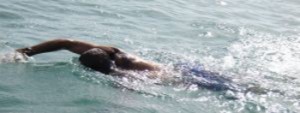With an ever-increasing population of running and cycling enthusiasts, good nutrition tips for swimmers are getting harder to come by. Luckily, the same carbo-loading scenarios that are appropriate for other distance sports are suitable for distance swimmers too.
 The Basics: Endurance athletes need to increase their access to available fuel. During event training, the prevailing wisdom is that an endurance swimmer should get about ~60 percent of their daily calories from carbohydrates with an increase to ~85 percent three weeks prior to race day. If this protocol is followed, an athlete can expect to increase muscle glycogen stores by ~35 percent, which will allow you to swim longer before fatigue sets in.
The Basics: Endurance athletes need to increase their access to available fuel. During event training, the prevailing wisdom is that an endurance swimmer should get about ~60 percent of their daily calories from carbohydrates with an increase to ~85 percent three weeks prior to race day. If this protocol is followed, an athlete can expect to increase muscle glycogen stores by ~35 percent, which will allow you to swim longer before fatigue sets in.
Another good practice is to make sure to eat a pre-swim meal. This will protect you against low blood sugar by restocking your liver with one hundred grams of carbohydrates. By eating a pre-swim meal you maintain your blood sugar levels which will help improve your energy prior to your swim start.
Avoid complex and fibrous carbohydrates. This might seem counter-intuitive but the last thing you want to think about on a long swim is clearing your bowels (you can read about my Ironman New Zealand race here, if you need a real-world example). Instead, include ~25 grams of protein and/or ~ 20grams of fat along with ~125 grams of carbohydrates two hours before the swim. This will help control your hunger and stabilize your blood sugar levels.
After one hour of moderate-to-intense swimming, blood sugars will result in fatigue and increase your risk of shivering and hypothermia – all of which can have a profound negative impact on performance. In an Ironman you will need to tough it out, but longer swimming distances of 10K and beyond generally take the trained swimmer two or more hours to complete. As such, feed zones are generally provided where coaches and support crews can help mediate calorie and fluid intake off of a floating pontoon, dock, pier, or anchored boat (for swims longer than 25K a team and escort boat are usually provided).
It is estimated that swimmers racing at moderate to high intensity will expend ~.065 calories per pound per minute or on average 500 to 700 calories per hour. You will not be able to replace all of these calories during the race, but if possible take in approximately 150 to 200 calories via carbohydrate liquids or gels along with small amounts of protein and fat, as well as some solid food if the race is extremely long.
In cases where aid stations are few and far between, or escort boats are not allowed, athletes may need to stuff gels into their suits (allowing two per hour in case feeding is missed or one is lost during swimming). The gel packs should be prepared pre-swim by cutting a small incision to allow for easier access during the race. An alternative is to place several gels into a four-ounce gel flask, diluted down with water to allow for ease of exit, and stuff the flask into the suit or a pocket in the suit.
Sweat rates for swimmers average around 125 milliliters (four ounces) per kilometer swum; which means that during a 10K event, about 40 ounces of fluid (including a total of 500-1000 milligrams of electrolytes, specifically sodium) is generally needed.
Special Note: As is with all endurance training, it is vital that you practice with any aids you plan to use on race day, as well as what you will do on race day, which can be broken down as follows:
1. Seek & Spot: Swimmers spot their coaches at the feeding station
2. Reach & Roll: Swimmers grab cups or bottles from coach/feeding stick and roll onto their backs to initiate feeding.
3. Gulp & Go: Swimmers swallow their nutrition quickly and continue swimming within two to three strokes.
4. Toss & Turn: Swimmers toss their cups/bottles and sight before turning over to continue swimming.
This post was adapted by an old article from Kim Mueller, a Registered Dietitian & Exercise Physiologist who owns Fuel Factor Nutrition (www.Fuel-Factor.com). Karen has helped many athletes nutritionally prepare for swims, including English Channel swimmers.
